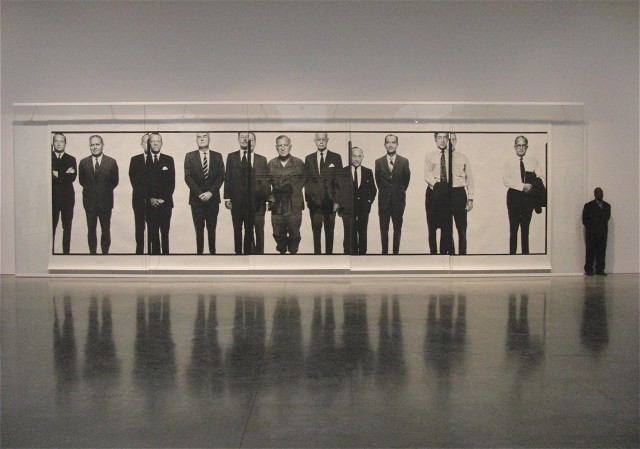
Richard Avedon, “The Mission Council,” silver gelatin prints, five panels mounted on linen, printed 1975, © The Richard Avedon Foundation (photo by twi-ny/mdr)
Gagosian Gallery
522 West 21st St. between Tenth & Eleventh Aves.
Monday – Friday through July 27, free, 10:00 am – 6:00 pm
212-741-1717
www.gagosian.com
www.richardavedon.com
Born and raised in New York City, photographer Richard Avedon began taking pictures at the YMHA when he was twelve, eventually honing his craft while serving in the Merchant Marine during WWII and studying at the New School. Renowned for his fashion photography, Avedon, who died in 2004 at the age of eighty-one, also specialized in silver gelatin portraits that explored the sociopolitical climate of America, particularly between 1969 and 1971. “My photographs don’t go below the surface,” he once said. “I have great faith in surfaces. A good one is full of clues.” Extended through July 27 at Gagosian’s Twenty-first St. gallery, “Richard Avedon: Murals & Portraits” features spectacular murals and intimate portraits that have beautiful surfaces indeed while providing plenty of clues about the state of the nation. Spread out in an awe-inspiring space designed by David Adjaye that holds surprises around every corner, the smaller portraits and massive murals — which run as high as ten feet and as long as thirty-five — feature such seminal counterculture figures as the Chicago Seven, Allen Ginsberg and his family, and Andy Warhol and such Factory denizens as Paul Morrissey, Candy Darling, Joe Dallesandro, Viva, Taylor Mead, and Gerard Malanga in addition to members of the Mission Council, a group of war administrators who influenced U.S. involvement in Vietnam. There are also smaller portraits of writers Brendan Behan, Julius Lester, and Jean Genet, activist Julian Bond, the sons of Julius and Ethel Rosenberg, Ginsberg and Peter Orlovsky naked, civil rights lawyers Leonard Weinglass, William Kunstler, and Florynce Kennedy, Nixon secretary Rose Mary Woods, and Vietnamese survivors of napalm attacks that put the pro- and antiwar movements and the sexual revolution in perspective, supplemented by vitrines containing paraphernalia relating to the nearby photographs and specific subject matter. Made before the era of digital manipulation and Photoshop, the large-scale murals, which include some subjects twice in the same series of panels, hang loosely behind sheets of plexiglass in an almost nonchalant way that adds to their mystique. The lighting also affects the murals, casting shadows of the men and women across the floor and even reflecting the mural opposite; although it was most likely accidental, it is quite intriguing to look at the eleven men of the Mission Council with a small, subtle reflection of nude factory members ghosted over them.